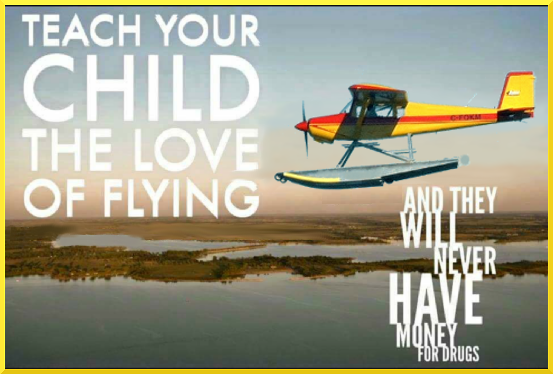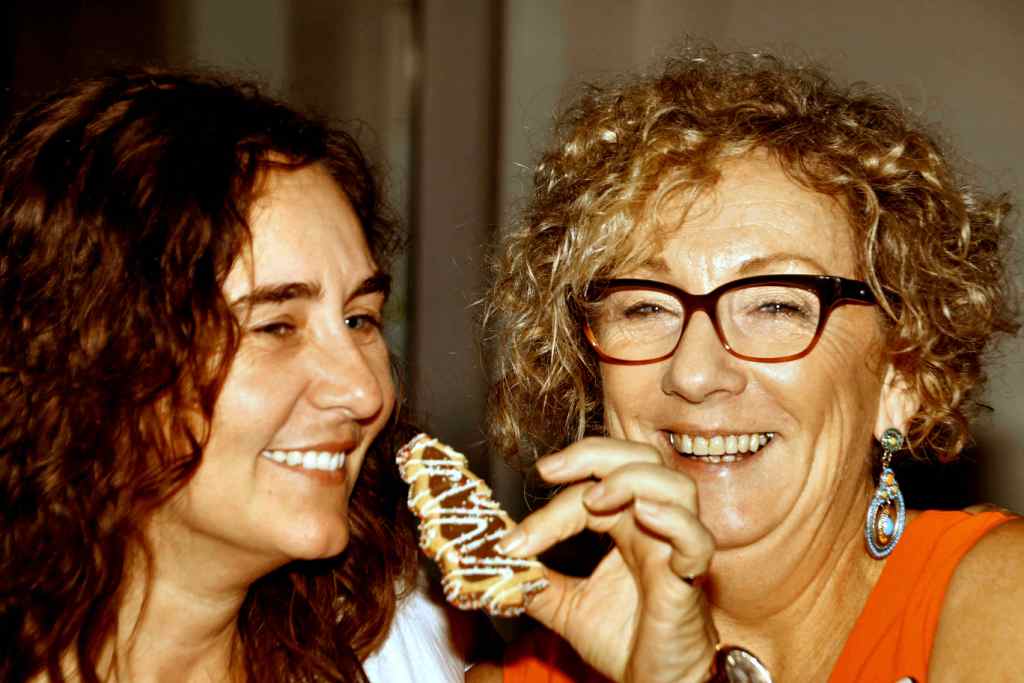|
|
||||||||||||||||||||||
|
|
||||||||||||||||||||||
|
Privacy Policy | Editorial Policy | Profit Policy | Join the Association | List of Members | Contact us | Index | Links |
||||||||||||||||||||||
|
Back Go to page: 1 2 3 4 5 6 7 8 9 10 11 12 13 14 15 16 17 18 19 20 Forward
|
||||||||||||||||||||||
|
|
||||||||||||||||||||||
|
Pedro’s Patter.
Jungle Survival.
As part of aircrew qualification, pilots, navigators and signallers (later called airborne electronics officers) had to attend a two-week Jungle Survival School, run by the Army at Canungra in Queensland. Our dress for the course was standard issue flying suits and combat boots.
The first week was spent learning jungle survival techniques, such as living off the land by day. It's amazing what is out there. We were shown how to collect rain water from plants and other vines and how to harvest the hearts of Palm trees.
At night we had to live in a jungle environment, cooking our own meals and sleeping in improvised hammocks made from parachute silk, simulating a situation following an emergency landing/bail out. We were issued with an emergency ration pack, such as you would find with a parachute. The pack contained such exciting items as an oatmeal block, to mix with water and a brick-hard block of chocolate, along with vegetable extracts and rice for making soup. We were also encouraged to augment these supplies by fishing for and cooking eels from a nearby stream. The instructor claimed cooked eels tasted like chicken. What a joke!
At the end of this introductory week our half-starved attendees were herded into the back of an army truck and driven to a beer garden in Surfers Paradise. Needless to say, after our deprivation we ate BBQ steaks and drank the local beer to excess.
Back to Canungra. After this sadistic interruption to our jungle routine we embarked on the second week of the course. We again climbed aboard the army truck, this time with the canvas sides rolled down so we couldn't see to where we were being taken and were literally dumped into virgin jungle, each with a parachute pack, emergency rations and a map with instructions for navigating to an RV point and a time required to meet there a week hence. We were split into pairs, each pair deciding how best to get to the RV point.
At first we stuck together as a group, navigating our way down a dry creek bed full of large boulders. I have two memories of this, the first being of one of the group, Stan Clark, falling head over heels on every rock he stepped on, the second of the funny man of the group, Nick Watling, who made us all laugh until we reached the river at the bottom of the creek bed. (Stan, now deceased, ended up an air commodore after an illustrious Air Force career while Nick ran the Flying Doctor service out of Cairns). At the river we resumed our pairings and individual navigation.
It was January, the middle of the wet season in Queensland. As we trudged around in the jungle it rained continuously. My partner was Bruce Grayson. Just before it got dark we selected a spot to set up our "para-hammocks" for what promised to be a miserable night. We found suitable small trees to tie our hammocks to and huddling underneath managed to light a small fire to cook a very basic meal. I think it was some kind of soup. After that it was completely dark so, soaking wet we climbed into our hammocks for what promised to be a very uncomfortable night. We steamed dry during the night ready for the next exciting day.
Our slumber was occasionally interrupted by strange jungle noises and thumps on the sides of our hammocks by unknown creatures. Enclosed in our parahammocks in complete darkness all we could do was ignore both, hoping we were not being attacked by malevolent jungle creatures.
Breakfast was made by shaving an oatmeal block into our survival pack tin and boiling the result with water. I suppose we were so hungry we would have eaten anything.
After breakfast Bruce and I headed out, maps and
machetes in hand. We plotted a route which seemed to head towards
our RV point, slashing our way through virgin jungle. On the
Following our chosen route on the map we came upon an unmarked chasm which we realised was impossible to cross. Enticingly the RV point was not too far across the chasm from our present position. We turned and followed the edge and were pleased to find a large fallen tree which reached across to the other side. I held Bruce's hand while he gingerly stepped on the log and managed to cross over. My turn. I got half way and slipped, falling into a springy mass of lantana vines. I still had a firm grip on my machete. Up to that point I'd never contemplated suicide but I swear if I could have manoeuvred my machete around I would have slit my throat. Somehow I managed to get out and across to join Bruce and we continued on our way.
The rest of the week was basically a repeat. At the end of the sixth day we identified the RV point and met up with our bedraggled group of "survivors". We set up camp and waited in trepidation for our rescue vehicle. For the first time we were pleased to see the army truck rumbling towards us and even more pleased when we were driven to the mess for our first hearty breakfast in a fortnight.
The culmination of the course was a presentation to each of us of an elaborate certificate saying we had successfully completed the Army Jungle Survival course.
*****
Popondetta.
Popondetta is a typical Caribou strip inland from the north coast of PNG. My crew and I had to drop someone in there one morning after heavy rain. We established contact with the ground party and asked for a strip report. "Come on in - it's fine here" was the reply. The strip looked all right so we set up a circuit for a good look and decided to go in.
The landing was OK but after turning off the strip it was apparent we were about to get bogged. Cursing our optimistic report I applied full power and we skidded into the parking area which, unlike the strip, was relatively dry. Another lesson learnt: don't always trust strip reports (unless of course you get the official one – tb).
Tapini is another strip guaranteed to stimulate the stomach muscles. The strip was situated in a valley and nick named the Tapini ILS due to a rather nerve racking circuit and landing. Having overflown the strip and setting up on a downwind leg from which the strip was invisible behind a ridge, one had to guess when to turn base, hoping the strip would once more come into view. Hence the "ILS"' and a short finals setting up for landing on the short strip. I'm not even sure why we used to go there - just for practice I guess.
Click the centre of the pic below to see video of the approach and departure taken from a Porter – it’s easy when you have GPS and it’s 8/8 blue!!
PNG is, or was, littered with war time wrecked aircraft. Some of these have been recovered and shipped to Australia for restoration by enthusiasts, but the PNG government has since put a stop to that. One old war time aerodrome which I overflew several times and later regretted not exploring, was Aitape, northwest of Moresby. Clearly visible from the air were Lightnings, B24s and many other war time aircraft. Another was Vanimo, near the PNG border with West Iran, still in use as a working airfield.
Another grave yard for WW II aircraft is Bootless Bay, a strip of water on the extended centreline of the main runway at Jacksons field, the international airport of the country. Quite visible from the air is a line of wrecked aircraft, B29s and other types, on the bottom of the bay.
|
||||||||||||||||||||||
|
|
||||||||||||||||||||||
|
One wonders whether low cloud or fuel starvation claimed the victims.
*****
The Solomons.
One of the longer Navaid checking trips in the F27 was to the Solomon Islands. If you look at a map the route almost describes the arc of a circle, starting from Port Moresby.
The first leg was of course from the Flying Unit home base at Essendon to Moresby, a long day with an overnight stop prior to continuing on to Honiara, the site of our NDB commissioning task.
Getting to Honiara involved changing from PNG to the Solomons and of course clearing Customs at Kieta. This involved predictable paperwork. The Customs officer laboriously filled out the forms and then took us to another office for stamping and signature, finally returning to the first office to complete the process. There was no hurrying this man up.
Our accommodation at Honiara was a very pleasant motel, our rooms overlooking the beach, in fact directly outside sliding doors to our rooms. I can't remember dinner that night but I'm sure it was agreeable.
Next day we got on with the job, planning to finish on the second day. Due to duty time regulations we had two days off before returning to PNG. We had a rental car and decided to drive over to Tambia beach, a well-known local picnic spot. On the way we had to cross a shallow creek. We managed to do this without any grief.
Tambia Beach was a delightful spot, backed up by a line of flowering tropical shrubs. We were soon into our swimming togs and into the water, a shade under body temperature. When we left the water and sat on our beach towels we were approached by a dark skinned native carrying a silver tray of cocktails, a most welcome complement to our seaside sojourn.
Offshore was a wreck, the remains of the filming of the movie "South Pacific". A good day was had by all. On departure for PNG we passed the wreck of an aircraft embedded in the tree-line. Two more overnights and we were home to Essendon airport.
*****
Gingin.
As enjoyable as flying and instructing on the
Macchi was, there were moments of boredom. When AFTS got Gingin
(satellite airfield about 40 klm north of RAAF Pearce) up and
running it was decided to bus some of the students up there to be
met by their instructors who, of
The trick was to judge the speed so that joining a left base for 27 wasted no airborne time. I can't remember who won the "prize"! Using Gingin of course allowed a wave of other students to fly out of Pearce while their compatriots used Gingin.
Make sense?
|
||||||||||||||||||||||
|
DVA (Qld) Christmas Party.
(These pics have been crunched to allow them to open quicker, you can access the HD copies by clicking each pic)
On Thursday the 3rd December, the Queensland “branch” of
the Department of Veterans’ Affairs (DVA) held their annual
Christmas Party/get together at their Brisbane HQ in the
It is also an ideal opportunity for “guests” to meet each other in a social environment and to swap ideas and pass on suggestions on how to deal with the many problems faced by both serving and ex-service people.
DVA is a huge organisation with an annual budget of $12.1 billion. It looks after 316,000 vets and their dependants through its State and Territory Departments, each of which is managed by a Deputy Commissioner. That $12.1 billion comprises $6.5 billion for income support and compensation (pensions), $5.5 billion for health (gold, white and orange cards) and $88.7 million for War Graves and Commemorations.
That is an awful lot of money.
Below is a table which shows the number of people from each conflict who are being helped by DVA. (Current Sept 2015)
|
||||||||||||||||||||||
|
||||||||||||||||||||||
|
The following tables show the number of current individual cards (Gold and White) that are on issue in each State. (Current Sept 2015).
|
||||||||||||||||||||||
|
||||||||||||||||||||||
|
||||||||||||||||||||||
|
The Department of Veterans’ Affairs employs around 2000 people throughout Australia. They have offices located in each state and territory capital, as well as smaller regional offices, known as Veterans’ Affairs Network (VAN) offices. You will find the locations of their offices HERE and their VAN Offices HERE.
DVA is responsible, under the Veterans' Entitlements Act 1986, for granting pensions, allowances and other benefits and arranging for the provision of treatment and other services for veterans, dependants of veterans and other persons in accordance with the Act. It also provides advice to the Minister on matters relating to the Act's operation and, subject to the Minister's control, generally administering the Act.
At times you hear grumbles about DVA, especially when the grumbler doesn’t get what he/she wants. We think that is very unfair. DVA have to administer the Act in their dealings and people should really direct their annoyance to the Government of the day, not at DVA and definitely not at a DVA employee. We have had dealings with DVA for many years now and have always found them very helpful and very pleasant with which to deal. Even though they have a huge number of “clients” they never make you feel like you’re just a number – we have always found them on the plus side of caring and supportive.
No matter where you are in Australia, you can contact the closest DVA office by ringing 133 254.
This year’s festival event was an excellent opportunity to meet Queensland’s new Deputy Commissioner – the delightful Jill Simpson and also the new Deputy President of the Repatriation Commission, Major General Craig Orme AM CSC.
Jill has recently joined the Department of Veterans’ Affairs as the
Queensland Deputy
Prior to joining the Department Jill was the State Director for the Department of Immigration and Border Protection and Global Manager Temporary Visa Processing. She has worked in Federal, State and Local Government including the Department of Defence as well as a number of private sector companies. She has extensive experience in client service delivery, large scale processing operations, stakeholder engagement and project management. She has managed a number of large scale projects including the implementation of the Family Assistance Office to Centrelink’s national call centre network and the creation of the Defence Service Centre to manage initial recruitment enquiries to the ADF and civilian personnel enquiries.
Jill has a keen interest in the engagement of younger veterans as
her son served in
Jill is supported by the un-flappable Amanda Green. Amanda is the Executive Assistant to the Deputy Commissioner, assisting with the day to day operations. She is DC’s gate keeper/problem solver and has worked for DVA for 5 years, 4 of those as the Assistant to the Deputy Commissioner. Prior to this position she worked in VAN Brisbane and in the Defence Home Ownership Assistance Scheme (DHOAS). She is a very experienced lady, always pleasant and is very good at her job. DVA are lucky to have her.
The new Deputy President, Major General Craig Orme (Retired),
(That’s AVM in the real money) has extensive knowledge of the
Defence, veteran and ex-service community, as well
Up until December 2014, Craig was the Commander Joint Task Force 633 in the Australian Defence Force. He had previously held positions as the Defence representative on the two year interdepartmental review of the Military Rehabilitation and Compensation Act 2004 and served as a member on the Military Rehabilitation and Compensation Commission and as a Deputy Commissioner of the Safety, Rehabilitation and Compensation Commission.
Craig brings with him over 37 years’ experience within the military, during which time he has worked in a range of strategic policy, operational and human resource management roles.
He began his five year term on 2 February 2015.
Seen at the “party” were:
|
||||||||||||||||||||||
|
Jim Hall and Vivienne McNally.
Jim is the President of the 3 Squadron Association while Vivienne looks after the Rehabilitation and Compensation section in DVA in Queensland. She is a very busy lady! |
||||||||||||||||||||||
|
|
||||||||||||||||||||||
|
A senior citizen said to his eighty-year old buddy: 'So I hear you're getting married?' 'Yep!' 'Do I know her?' 'Nope!' 'This woman, is she good looking?' 'Not really.' 'Is she a good cook?' 'Naw, she can't cook too well.' 'Does she have lots of money?' 'Nope! Poor as a church mouse.' 'Well, then, is she good in bed?' 'I don't know.' 'Why in the world do you want to marry her then?' 'Because she can still drive!'
|
||||||||||||||||||||||
|
|
||||||||||||||||||||||
|
Sharon Galvan. |
||||||||||||||||||||||
|
Sharon was a very popular girl that afternoon, she was doling out the prawns and other delightful delicacies – she was everyone’s favourite.
|
||||||||||||||||||||||
|
John Griffiths. |
||||||||||||||||||||||
|
For years John was one of the RAAF’s pilots, and during his career, flew most of the RAAF’s different types of aircraft, including a tour of Vietnam where he flew the mighty old Caribou (May 1968 to May 1969) and later the E model Herc on numerous supply/medivac missions.
After retirement from the RAAF (as a Wing Commander), he was appointed to the Australian Air Force Cadets as the Commanding Officer of Number 2 Wing. He has finally hung up his wings and is now a Director of the Air Cadet Alumini.
|
||||||||||||||||||||||
|
Barbara Bower, John Griffiths, Doug Bower. |
||||||||||||||||||||||
|
Many years ago, Doug was a firey at RAAF Richmond and was on duty
the day (Sept 1968) Caribou A4-233 landed on its nose wheel and ramp
door. The aircraft had just come out of the hangar after a D (major)
service and unbeknown to one and all, the rods that close the left
hand under-carriage doors when the gear is retracted had been put
back together the
The aircraft left Richmond on its proving flight with enough fuel for about 5 hours flight and with Bob “Father” May at the controls. Down the back were a bunch of blokes, all of whom had worked on the aircraft, RAAF rule number 1, you fix it, you fly in it.
When the gear went up the strut got all tangled in the rods and thereafter refused to either go right up or come back down again which was a bit of a problem for the crew and a hulluva problem for the blokes down the back.
After much jigging and jagging trying to get the gear loose, all on board finally came to the realisation that when Father eventually put the aircraft back on the ground at Richmond, a normal landing it was not going to be.
Now the Caribou was a pretty basic sort of aeroplane and although it was good at a lot of things, one thing it couldn’t do was jettison fuel. Rule number 1 for aircrew is to always have as much fuel on board as you can, the only exception to the rule being when you were about to crash or belly land the aeroplane. The exception to rule number 1 is there because the more fuel you have on board when you crash usually means the bigger the fire afterwards – pretty basic really. So, if you can’t jettison fuel, the only way to get rid of it is to use it up, so all on board had a wonderful sightseeing trip all around Sydney at about 2000ft, all having a go at flying the old girl which was in auto-rich and after a couple of hours, with the needles at 9.00 o’clock, it was time to bring her home.
You can get the nose wheel down in the Caribou by blowing a compressed air bottle, which they did and to save the belly of the aircraft as much as possible, Father lowered the ramp door and then set the aircraft up for a landing. As they crossed the fence, all engines were stopped, props were feathered and the aircraft was put down on its nose wheel. Father held it up as long as lift would allow and eventually the rear dropped and the Caribou made a copy-book two point landing.
As soon as the roll stopped, all on board left the aeroplane as though there was a keg on in one of the hangars, it was actually quite funny to see though those on board would not have seen the funny side at all. Thankfully there were no injuries, except Doug slipped in the foam and skinned his knee.
Apart from the poor old Framie who stuffed up the doors, the whole episode was handled in a very professional and expert manner. Bob, called Father because he was a bit older than most other pilots, was very experienced and due to his handling of the aircraft, it suffered only minimal damage and after replacing the ramp door, a VHF/UHF antenna that had about 3 inches shaved off its exterior from rubbing against the ground and after some new rods were fitted to the undercarriage doors, it was flying again practically next day. And when you look at the photo of the aircraft after it had come to a stop, you can see how well the fireys judged the length of the foam path, the aircraft came to a stop right at its end.
Doug is in the pic, squatting near the nose wheel, putting the pins in to stop the front strut from collapsing. The other bloke is John Lambert.
Sadly, this aircraft which was later attached to a flight of 3 aircraft in Port Moresby, was on a flight from Lae back to Moresby when it crashed, killing 25 of the 29 people on board, most of whom were kids.
|
||||||||||||||||||||||
|
L-R: Truus Perry, Barbara Bower, Pett Rayner.
|
||||||||||||||||||||||
|
These three lovely ladies all served in the RAAF, Truus was an accounting machine operator from 1966 to 1969 and spent most of her time at 2SD at Regents Park, Barbara was also an accounting machine operator, though she was posted to Richmond from 1964 – 1970 where she was swept off her feet by debonair Doug and Pett was a Teleg in the RAAF during the war years and served from 1944 to 1945.
|
||||||||||||||||||||||
|
|
||||||||||||||||||||||
|
Carol McDonald, Trevor Benneworth. |
||||||||||||||||||||||
|
Carol McDonald is the Assistant Director Case Coordination and is in charge of the Case Coordination Team in Queensland. Case Coordination assist clients identified at risk of self-harm or harm to others or with complex needs, to navigate DVA services and benefits in order to minimise the risk of self-harm and maximise quality of life. Case Coordinators also provide a DVA primary point of contact for the client and assist them and their families with other psychosocial needs external to DVA to help them enhance their quality of life.
While it was not possible to obtain the exact number of younger clients, most case coordinators advise that younger veterans (aged 45 years and less) represented around 50–60 per cent of their case loads.
Carol has a necessary and very responsible job.
Benneworth is there only because he can’t resist having his photo taken with pretty girls.
|
||||||||||||||||||||||
|
The Rats of Tobruk Association presented Jill with a plaque to the Department of Veterans’ Affairs in recognition of support and services rendered over the years. The plaque was presented by President Gordon Wallace 2/15 Inf/Btn, “Rat of Tobruk” (left) and Hon Secretary/Treasurer Jock Hunter Ex RAF (Ret)
|
||||||||||||||||||||||
|
|
||||||||||||||||||||||
|
|
||||||||||||||||||||||
|
|
||||||||||||||||||||||
|
Sharon Galvan and Carol McDonald. “Sorry Sharon, things have been a bit tight this year, here’s your Christmas present.”
|
||||||||||||||||||||||
|
|
||||||||||||||||||||||
|
|
||||||||||||||||||||||
|
|
||||||||||||||||||||||
|
|
||||||||||||||||||||||
|
Back Go to page: 1 2 3 4 5 6 7 8 9 10 11 12 13 14 15 16 17 18 19 20 Forward |
||||||||||||||||||||||
|
|
||||||||||||||||||||||

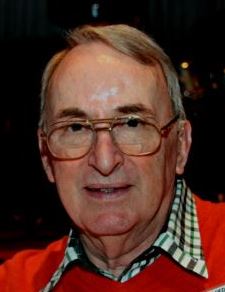
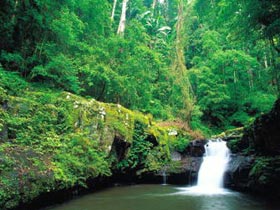 way we
discovered two unpleasant impediments. The first was what we were
later told were lawyer vines. They were a tangle of clinging
tendrils which if you merely brushed against them ensnared you to
the point where if you tried to pull away they would tear your
clothing to shreds. The second was, if one glanced upwards a
gigantic spider web with a huge tarantula in the middle. These
creatures reportedly ensnared and ate small birds. Such was the
jungle.
way we
discovered two unpleasant impediments. The first was what we were
later told were lawyer vines. They were a tangle of clinging
tendrils which if you merely brushed against them ensnared you to
the point where if you tried to pull away they would tear your
clothing to shreds. The second was, if one glanced upwards a
gigantic spider web with a huge tarantula in the middle. These
creatures reportedly ensnared and ate small birds. Such was the
jungle.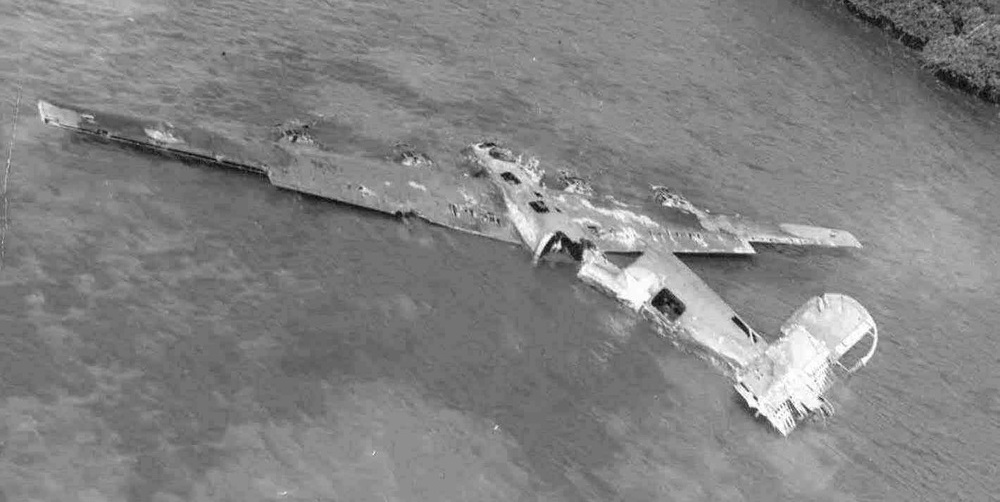
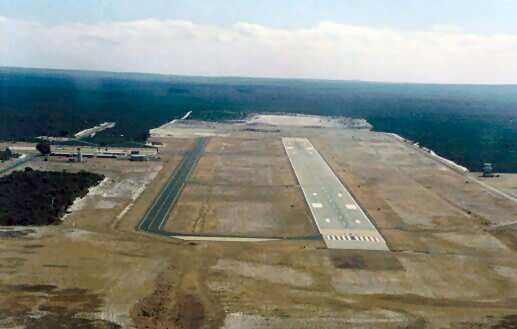 course, flew up. The boring bit was flyi
course, flew up. The boring bit was flyi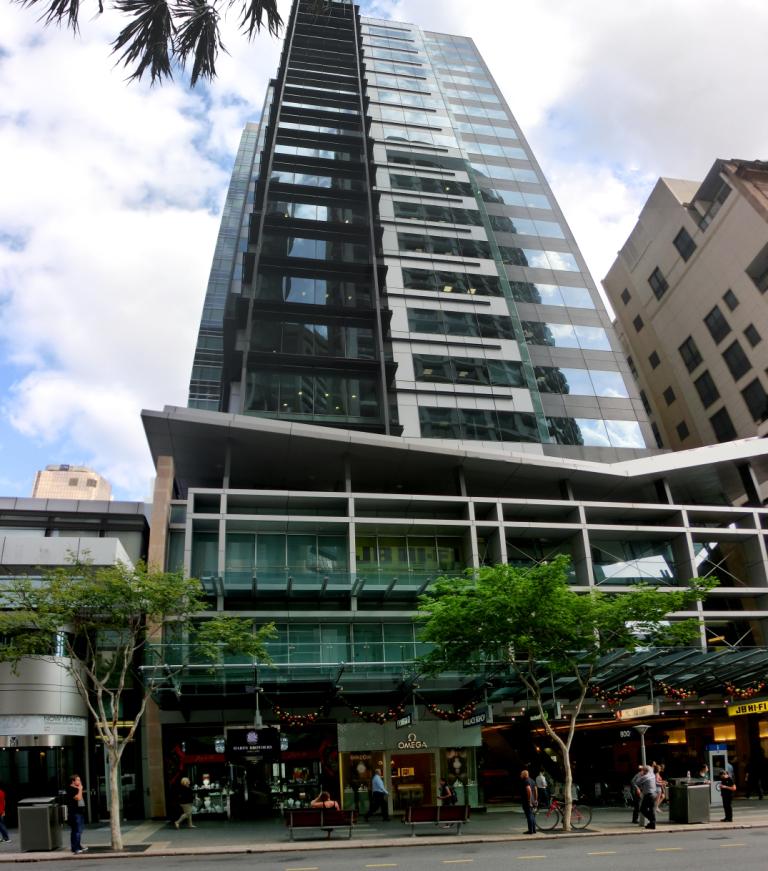 Bank of Qld building in Queen St. These social events are an ideal
opportunity for ESO people, ex-ADF Association members and Welfare
Groups to meet with the helpful DVA people with whom they have had
dealings over the year, to discuss any problems they have or foresee
or to get assistance with any claim or grant with which they are
dealing.
Bank of Qld building in Queen St. These social events are an ideal
opportunity for ESO people, ex-ADF Association members and Welfare
Groups to meet with the helpful DVA people with whom they have had
dealings over the year, to discuss any problems they have or foresee
or to get assistance with any claim or grant with which they are
dealing.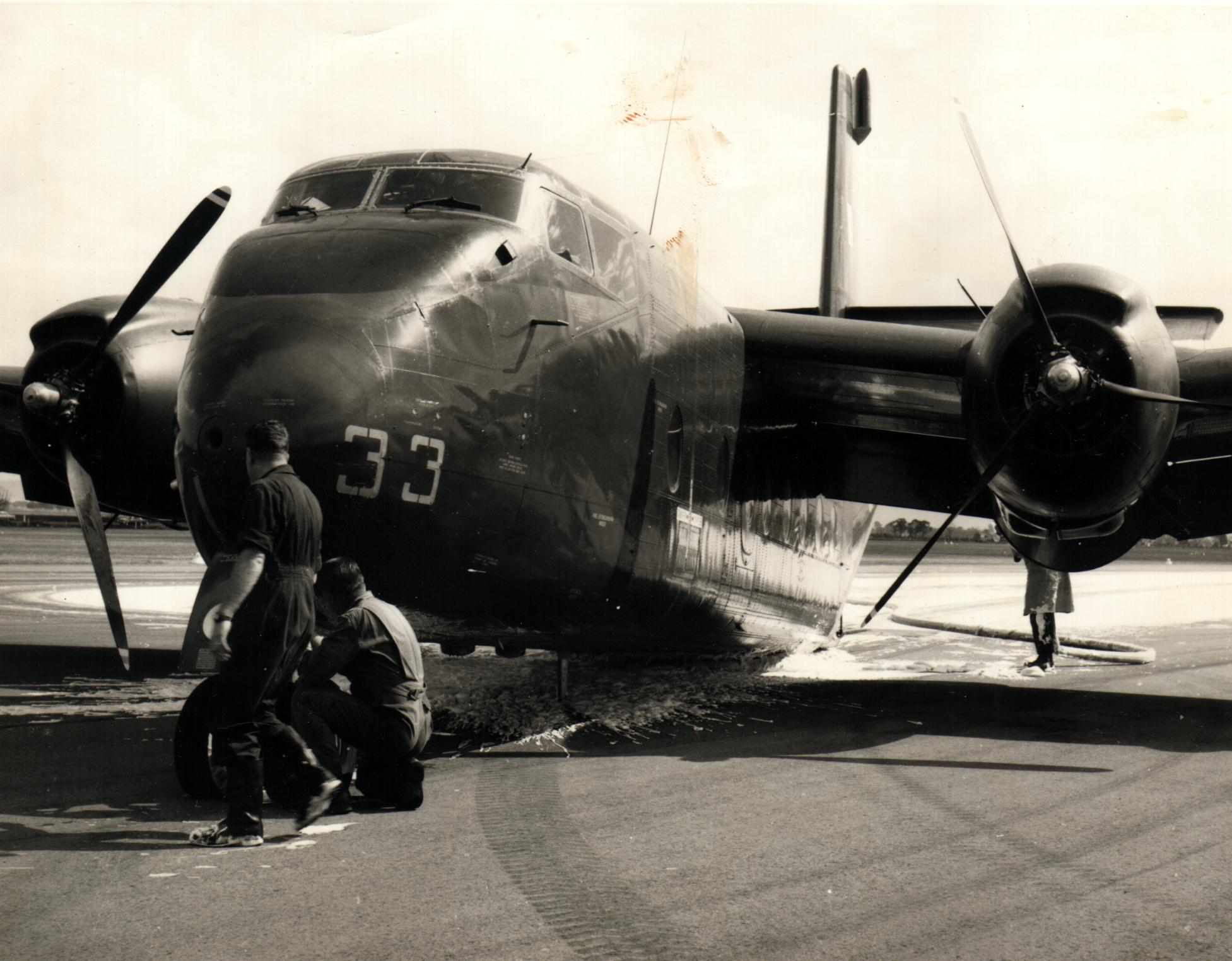
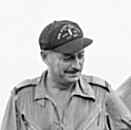 Father
had of course let Richmond ATC know of his predicament and they in
turn had flicked the problem straight to the fireys. With Father and
his team inbound, it was time for Doug Bower and his crew to get to
work. Out came the big red trucks and they laid a foam path from the
piano keys on 10 to about half way down the runway and as the word
had spread, practically everyone on base was out on the tarmac
waiting for the big event.
Father
had of course let Richmond ATC know of his predicament and they in
turn had flicked the problem straight to the fireys. With Father and
his team inbound, it was time for Doug Bower and his crew to get to
work. Out came the big red trucks and they laid a foam path from the
piano keys on 10 to about half way down the runway and as the word
had spread, practically everyone on base was out on the tarmac
waiting for the big event. 